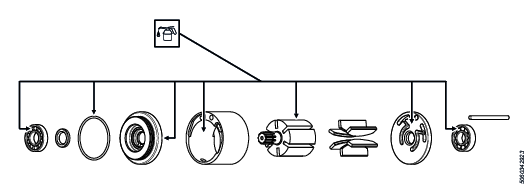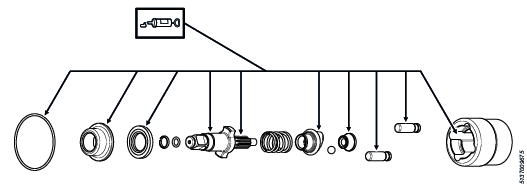Product Information
General Information
Safety Signal Words
The safety signal words Danger, Warning, Caution, and Notice have the following meanings:
DANGER | DANGER indicates a hazardous situation which, if not avoided, will result in death or serious injury. |
WARNING | WARNING indicates a hazardous situation which, if not avoided, could result in death or serious injury. |
CAUTION | CAUTION, used with the safety alert symbol, indicates a hazardous situation which, if not avoided, could result in minor or moderate injury. |
NOTICE | NOTICE is used to address practices not related to personal injury. |
Warranty
Product warranty will expire 12 months after the product is first taken into use, but will in any case expire at the latest 13 months after delivery.
Normal wear and tear on parts is not included within the warranty.
Normal wear and tear is that which requires a part change or other adjustment/overhaul during standard tools maintenance typical for that period (expressed in time, operation hours or otherwise).
The product warranty relies on the correct use, maintenance, and repair of the tool and its component parts.
Damage to parts that occurs as a result of inadequate maintenance or performed by parties other than Atlas Copco or their Certified Service Partners during the warranty period is not covered by the warranty.
To avoid damage or destruction of tool parts, service the tool according to the recommended maintenance schedules and follow the correct instructions.
Warranty repairs are only performed in Atlas Copco workshops or by Certified Service Partners.
Atlas Copco offers extended warranty and state of the art preventive maintenance through its ToolCover contracts. For further information contact your local Service representative.
For electrical motors:
Warranty will only apply when the electric motor has not been opened.
Website
Information concerning our Products, Accessories, Spare Parts and Published Matters can be found on the Atlas Copco website.
Please visit: www.atlascopco.com.
ServAid
ServAid is a portal that is continuously updated and contains Technical Information, such as:
Regulatory and Safety Information
Technical Data
Installation, Operation and Service Instructions
Spare Parts Lists
Accessories
Dimensional Drawings
Please visit: https://servaid.atlascopco.com.
For further Technical Information, please contact your local Atlas Copco representative.
Safety Data Sheets MSDS/SDS
The Safety Data Sheets describe the chemical products sold by Atlas Copco.
Please consult the Atlas Copco website for more information www.atlascopco.com/sds.
Installation of Vibrating Tools
We recommend using a minimum length of 300 mm (12") of flexible hose for compressed air between a vibrating tool and the quick-action coupling.
Country of Origin
For the Country of Origin, please refer to the information on the product label.
Dimensional Drawings
Dimensional Drawings can be found either in the Dimensional Drawings Archive, or on ServAid.
Please visit: http://webbox.atlascopco.com/webbox/dimdrw or https://servaid.atlascopco.com.
Overview
Technical Product Data
Technical Product Data can be found on either ServAid, or the Atlas Copco website.
Please visit: https://servaid.atlascopco.com or www.atlascopco.com.
Service Overview
Overview
The table below shows the recommended service interval.
The service must only be done by an authorized workshop or qualified service technician.
Daily | Free speed check |
Air lubrication | |
Weekly | Silencer inspection |
Strainer inspection | |
Half yearly | Rating and markings inspection |
Yearly or after 100000 tightenings | Overhaul |
Threaded connections lubrication and tightening |
Overhaul and preventive maintenance
An overhaul should be done once per year or after a maximum of 100.000 tightening. More frequent preventive maintenance and overhaul are needed if the tool is used in heavy-duty operations. If the tool is not working correctly take it out of service immediately for inspection.
At overhaul and maintenance:
clean all parts thoroughly
replace worn or defective parts
lubricate the threads and o-rings with grease before assembly
make sure that the threaded connections on the tool are tightened in accordance with the specifications on the exploded views
Service Recommendations
Preventive maintenance is recommended at regular intervals. See the detailed information on preventive maintenance. If the product is not working properly, take it out of service and inspect it.
If no detailed information about preventive maintenance is included, follow these general guidelines:
Clean appropriate parts accurately
Replace any defective or worn parts
Installation
Installation Requirements
Air Quality
For optimum performance and maximum product life we recommend the use of compressed air with a maximum dew point of +10°C (50°F). We also recommend to install an Atlas Copco refrigeration type air dryer.
Use a separate air filter which removes solid particles larger than 30 microns and more than 90% of liquid water. Install the filter as close as possible to the product and prior to any other air preparation units to avoid pressure drop.
For impulse/impact tools make sure to use lubricators adjusted for these tools. Regular lubricators will add too much oil and therefore decrease the tool performance due to too much oil in the motor.
Make sure that the hose and couplings are clean and free from dust before connecting to the tool.
Both lubricated and lubrication free products will benefit from a small quantity of oil supplied from a lubricator.
Air Lubrication Guide
Brand | Air lubrication |
|---|---|
Atlas Copco | Optimizer (1 liter) 9090 0000 04 |
Q8 | Chopin 46 |
Shell | Shell Air Tool Oil S2 A 320 |
Compressed Air Connection
For correct air pressure and hose size, see the Technical Product Data on - https://servaid.atlascopco.com or www.atlascopco.com.
Make sure that the hose and couplings are clean and free from dust before connecting to the tool.
Operation
Ergonomic Guidelines
Consider your workstation as you read through this list of general ergonomic guidelines to identify areas for improvement in posture, component placement, or work environment.
Take frequent breaks and change work positions frequently.
Adapt the workstation area to your needs and the work task.
Adjust for a convenient reach range by determining where parts and tools need to be located to avoid static load.
Use workstation equipment such as tables and chairs appropriate for the work task.
Avoid work positions above shoulder level or with static holding during assembly operations.
When working above shoulder level, reduce the load on the static muscles by lowering the weight of the tool, using for example torque arms, hose reels or weight balancers. You can also reduce the load on the static muscles by holding the tool close to the body.
Take frequent breaks.
Avoid extreme arm or wrist postures, particularly during operations requiring a degree of force.
Adjust for a convenient field of vision that requires minimal eye and head movements.
Use appropriate lighting for the work task.
Select the appropriate tool for the work task.
In noisy environments, use ear protection equipment.
Use high-quality inserted tools and consumables to minimize exposure to excessive levels of vibration.
Minimize exposure to reaction forces.
When cutting:
A cut-off wheel can get stuck if the cut-off wheel is bent or not guided properly. Use the correct flange for the cut-off wheel and avoid bending the cut-off wheel during operation.
When drilling:
The drill might stall when the drill bit breaks through. Use support handles if the stall torque is high. The safety standard ISO11148 part 3 recommends using a device to absorb a reaction torque above 10 Nm for pistol grip tools and 4 Nm for straight tools.
When using direct-driven screwdrivers or nutrunners:
Reaction forces depend on the tool settings and joint characteristics. Strength and posture determine the amount of reaction force that an operator can tolerate. Adapt the torque setting to the operator's strength and posture and use a torque arm or reaction bar if the torque is too high.
In dusty environments, use a dust extraction system or wear a mouth protection mask.
Operating Instructions
Long sockets and extensions
Use extensions and standard sockets instead of long or extra long sockets as the lower inertia/mass of the extension will give less stress on the impact mechanism.
However an extension will reduce the applied torque to some degree.

Tightening time
Use a tightening time of 1-5 seconds. Longer tightening or loosening times will increase wear, cause malfunction and risk of breakage.
Tightening torque
The tightening torque force depend on:
the air pressure
the tightening time
the bolted joint
The tightening torque force is reduced by extension pieces and worn sockets. Oversized power sockets (diameter or length) will overload the impact mechanism and reduce the life of vital parts.
Use the impact wrench within the specified torque range.
Never override the recommended maximum tightening torque.
Service
Maintenance Instructions
Overview
The table below shows the recommended service interval.
The service must only be done by an authorized workshop or qualified service technician.
Daily | Free speed check |
Air lubrication | |
Weekly | Silencer inspection |
Strainer inspection | |
Half yearly | Rating and markings inspection |
Yearly or after 100000 tightenings | Overhaul |
Threaded connections lubrication and tightening |
Overhaul and preventive maintenance
An overhaul should be done once per year or after a maximum of 100.000 tightening. More frequent preventive maintenance and overhaul are needed if the tool is used in heavy-duty operations. If the tool is not working correctly take it out of service immediately for inspection.
At overhaul and maintenance:
clean all parts thoroughly
replace worn or defective parts
lubricate the threads and o-rings with grease before assembly
make sure that the threaded connections on the tool are tightened in accordance with the specifications on the exploded views
Service Recommendations
Preventive maintenance is recommended at regular intervals. See the detailed information on preventive maintenance. If the product is not working properly, take it out of service and inspect it.
If no detailed information about preventive maintenance is included, follow these general guidelines:
Clean appropriate parts accurately
Replace any defective or worn parts
Inspection of strainer
Clean the strainer at the air inlet frequently to prevent clogging which decreases the capacity of the tool. Replace a defective or worn strainer.
Inspection of motor parts

All parts | Clean all parts before inspection. |
Bearings | Make sure that the bearings are free from damages and runs smoothly. |
End plates |
|
Rotor | Make sure:
|
Cylinder |
|
Inspection of silencer
Change or clean the filters regularly. Clogged filters will reduce power output.
Lubrication Instructions
Rust Protection and Cleaning
Water in the compressed air can cause rust. To prevent rust we strongly recommend to install an air dryer.
Water and particles can cause sticking of vanes and valves. This can be prevented by installing an air filter close to the product to avoid pressure drop.
Before longer stand stills always protect your tool by adding a few drops of oil into the air inlet. Run the tool for 5–10 seconds and absorb any access oil at the air outlet in a cloth.
Lubricating guide
Use lubricants of good quality. The oils and greases listed in the lubrication table are examples of lubricants that can be recommended.
Brand | General purpose Bearings | Impact mechanism |
|---|---|---|
BP | Energrease LS-EP2 | |
Castrol | Spheerol EP L2 | |
Esso | Beacon EP2 | |
Q8 | Rembrandt EP2 | |
Mobil | Mobilegrease XHP 222 | |
Shell | Alvania EP2 | Alvania Grease RL2 |
Texaco | Multifak EP2 | |
Molycote | BR2 Plus |
Lubrication of motor parts
Apply a layer of oil where indicated.

Lubrication of impact mechanism
Spread a thin layer of grease on all sliding and impact surfaces, inside the cavity of the hammer and on the driver flange.

Recycling
Environmental Regulations
When a product has served its purpose it has to be recycled properly. Dismantle the product and recycle the components in accordance with local legislation.
Batteries shall be taken care of by your national battery recovery organization.